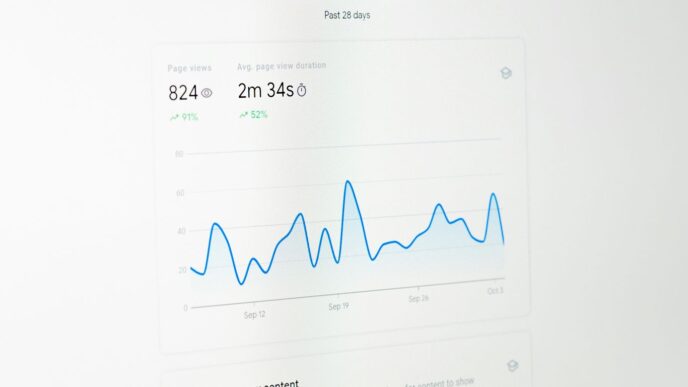The Evolution of Humanoid Robots
Building a robot that looks and acts like a human isn’t just about making something that resembles us. It’s about creating a machine that can actually function in the world we’ve built – a world full of doorknobs, stairs, and everyday objects designed for human hands and bodies. For a long time, this was mostly science fiction, but a lot has changed. The journey from clunky prototypes to the more capable machines we see today is a story of many different technologies coming together.
Foundational Innovations in Robotics
Early on, robotics was a lot about basic movement and simple tasks. Think of the robotic arms you see in factories, moving with precision but not much flexibility. The big shift towards humanoids really kicked off when researchers started thinking about how robots could do more than just repeat programmed actions. They needed to perceive their surroundings, make decisions, and move in ways that were more adaptable. This meant looking at things like:
- Mechanical Design: Figuring out how to build joints and limbs that could mimic human range of motion without being too heavy or using too much power.
- Control Systems: Developing ways to manage all those moving parts so the robot could balance, walk, and manipulate objects smoothly.
- Sensors: Giving robots the ability to ‘see’ and ‘feel’ their environment, which was a huge hurdle.
It’s not just about one breakthrough; it’s been a slow build-up of many small steps across different fields.
Hardware and Sensor Architecture Advancements
Making a robot that can walk and interact requires some pretty sophisticated hardware. The physical body, or the ‘architecture,’ has to be just right. This includes:
- Actuators: These are like the muscles of the robot, providing the power for movement. Getting them strong enough, precise enough, and efficient enough has been a major challenge.
- Sensors: Robots need to sense the world. This means cameras for vision, lidar for mapping, force sensors in the hands and feet to know how hard they’re pushing or how stable they are, and even microphones for hearing. The quality and integration of these sensors directly impact how well a robot can understand and react to its surroundings.
- Power and Thermal Management: All this hardware uses a lot of energy and generates heat. Designing systems that can power the robot for a useful amount of time and keep it from overheating is a constant engineering puzzle.
The Role of Real-Time Software and Control Logic
Having great hardware is only half the battle. You need software that can make it all work together, and do it now. This is where real-time software and control logic come in. Imagine a robot trying to catch a ball – it needs to see the ball, predict its path, and move its arm to intercept it, all in a fraction of a second. This involves:
- Perception Algorithms: Software that takes raw sensor data (like camera images) and turns it into useful information (like identifying an object and its location).
- Planning and Decision Making: Once the robot knows what’s around it, it needs to figure out what to do next. This could be planning a path to walk across a room or deciding how to pick up an object.
- Low-Level Control: This is the software that translates the high-level decisions into specific commands for the robot’s motors and joints, making sure movements are smooth and stable. It’s like the robot’s nervous system, sending signals to its muscles.
Getting all these pieces to work in sync, without any noticeable delay, is what makes a humanoid robot truly functional in our dynamic world.
AI’s Transformative Impact on Humanoid Capabilities
Artificial intelligence is changing what humanoid robots can do, bringing them closer to being useful partners in real-world tasks. Over the last few years, new AI models and smarter software have turned yesterday’s science fiction into something you can almost run into at the mall or your doctor’s office. Let’s break down where AI is really making a difference in humanoid robots today.
Generative AI in Robotic Manipulation
If you want a robot to handle unpredictable situations, like sorting a messy pile or pouring a drink—generative AI is where the magic happens. These models help robots plan their moves nearly on the fly, learning from thousands of virtual (and real) trials. Robots today can practice gripping, stacking, or opening doors in simulated worlds, then transfer that knowledge to real hands and tools.
Key changes:
- Robots try out solutions in simulation before testing on real objects
- Generative models make it easier to adapt to new shapes, tools, or tasks
- Feedback loops between trial and error allow constant improvement
| Task | Pre-AI Success (%) | AI-Powered Success (%) |
|---|---|---|
| Sorting objects | 35 | 82 |
| Opening containers | 25 | 78 |
| Packing shelves | 41 | 91 |
Advancements in Machine Learning and Computer Vision
Machine learning has made it possible for robots to actually see and understand their surroundings instead of just reacting to simple sensors. Tools like computer vision allow them to recognize a face, read a label, or estimate how far away something is—stuff most humans take for granted every day.
Some standout improvements:
- Robots distinguish between similar-looking objects (like apples and tennis balls)
- They can map a room, avoid obstacles, and plan paths in real time
- More accurate hand-eye coordination, so tasks like folding laundry or delivering packages go smoother
Natural Language Processing for Human-Robot Interaction
Let’s be honest—if you call your robot and it just sits there, it’s not that helpful. That’s where natural language processing (NLP) steps in. Robots now understand spoken commands, respond to casual questions (like, “Where’s my umbrella?”), and even handle follow-up conversations.
How NLP is showing up in robotics:
- Robots for customer service: greeting, answering questions, or helping shoppers
- Personal assistants at home: reminders, simple chores, or social chat
- Hospital support: delivering supplies or explaining routines to patients
The bottom line: With stronger AI, humanoid robots are less like complicated machines and more like adaptable, helpful teammates. A lot remains to be done, but the gap between what’s possible and what’s practical is getting smaller every day.
Navigating the Humanoid Robot Landscape
The world of humanoid robots is buzzing right now, and it feels like there’s a new company or a big investment announcement every other week. It’s not just a few big names anymore; there’s a whole mix of players trying to make their mark. We’ve got the established tech giants pouring money into development, alongside a bunch of nimble startups with fresh ideas. Plus, universities and research labs are still churning out important discoveries that push the whole field forward.
Key Players in the Humanoid Robot Industry
Right now, a few big companies are really making waves. Think of the ones you’ve probably heard of, the ones with the resources to build and test these complex machines on a larger scale. They’re often the ones setting the pace, showing off impressive demos, and attracting significant funding. Their work is crucial for showing what’s possible and for pushing the boundaries of what these robots can do.
Emerging Startups and Their Innovations
But it’s not all about the big guys. There are tons of smaller companies popping up, often focusing on a specific problem or a unique approach. Some are developing specialized hardware, others are working on smarter AI brains, and some are trying to figure out how to make robots work better in everyday environments. These startups are where a lot of the really creative and sometimes unexpected breakthroughs happen. They’re not afraid to try different things, and that’s how we get new ideas into the mix.
The Influence of Academic Research
We can’t forget about the universities and research institutions. They’re the bedrock of a lot of this progress. Long before a company can even think about mass production, researchers are in labs, working on the fundamental science. They’re publishing papers, training the next generation of roboticists, and exploring ideas that might not have immediate commercial appeal but are vital for long-term advancement. Their work often lays the groundwork for the innovations we see from the industry later on.
Real-World Applications and Future Potential
So, where are these humanoid robots actually going to show up, and what could they end up doing? It’s not just science fiction anymore. Right now, the big push is for them to handle jobs that are either too dangerous, too boring, or just plain unpleasant for people. Think about factories or warehouses where robots can move heavy boxes all day long without getting tired or complaining. This helps with labor shortages and boosts how much gets done.
Humanoid Robots in Manufacturing and Warehousing
In factories, these robots can take over repetitive tasks, freeing up human workers for more complex jobs. Warehouses are another prime spot. Imagine robots zipping around, picking and packing orders. They’re great for tasks that are dull and repetitive, like moving items from one place to another. This isn’t just about replacing people; it’s about making operations smoother and safer. The goal is to have robots handle the grunt work so humans can focus on oversight and problem-solving.
Potential in Healthcare and Personal Assistance
Looking ahead, the possibilities get even more interesting. In healthcare, robots could assist nurses with tasks like lifting patients or delivering medications, reducing physical strain on staff. They might also help with basic patient monitoring. For personal assistance, picture a robot helping out an elderly person at home, reminding them to take medication, or even helping with simple chores. It’s about providing support and making daily life a bit easier.
The Blurring Line Between Automation and Companionship
This is where things get really fascinating, and maybe a little weird. As robots get better at interacting with us, using things like natural language processing, they could start to feel less like tools and more like companions. Think about robots in retail that can chat with customers, answer questions, and make recommendations. Or even robots in our homes that can hold conversations. It’s a bit of a leap, but the idea is that these machines could eventually offer a form of interaction that goes beyond just task completion. It raises questions about what
Challenges and Constraints in Humanoid Development
Building robots that look and act like us isn’t just about making them shiny and anthropomorphic. There are some pretty big hurdles we’re still trying to clear. It’s not just a matter of slapping some AI in a metal body; it’s a complex engineering puzzle.
Technical Realities Limiting Full Autonomy
One of the biggest headaches is getting these robots to handle the real world with the same grace we do. Think about everyday tasks: opening a tricky jar, navigating a crowded sidewalk, or even just picking up a dropped coin. These require a level of dexterity and fine motor control that’s still really tough to nail. The ability to perform delicate tasks, like manipulating small objects or operating complex controls, remains a significant challenge. Then there’s the whole issue of power. Humanoid robots are energy hogs. Battery life is a major bottleneck, limiting how long they can actually work without needing a recharge. This is a big deal if you want them doing jobs that require long, continuous shifts, like driving a truck or providing round-the-clock care.
The Need for Extensive Data and Generalization
Robots learn from data, a lot of it. The problem is, the data a robot collects is often super specific to the exact hardware it’s running on. If you change even a small part of the robot – say, a different type of sensor or a slightly altered joint – all that previous data might become useless. This makes it hard to improve the robot’s software over time without constantly retraining it from scratch. Companies are betting on the humanoid form factor because our world is built for humans. The idea is that a general-purpose humanoid could eventually do many different jobs without needing major hardware overhauls. This way, they can focus on collecting more data and making the software smarter, creating a sort of positive feedback loop.
Ethical Design and Responsibility in Robotics
As these robots become more common, especially in our homes and workplaces, we need to think hard about how they’re designed. It’s not just about making them functional; it’s about making them safe and trustworthy. Who is responsible when a robot makes a mistake? How do we ensure they respect our privacy and don’t collect more information than they need? These aren’t just technical questions; they’re ethical ones. We need to build systems where decisions can be traced, and actions can be understood. This means thinking about responsibility right from the start, embedding it into the code itself, not just relying on future regulations.
The Future of Humanoid Robotics
So, what’s next for these human-like machines? It’s a big question, and honestly, the picture is still forming. We’re seeing a lot of money pouring into companies trying to build these general-purpose robots, the kind that could theoretically do a lot of different jobs. Think Tesla’s Optimus or Figure AI’s robots. It feels like they’re just around the corner, right? But when you dig a little deeper, the actual technical hurdles are pretty significant.
The Humanoid Arms Race and Investment Strategies
Right now, it feels like a bit of a race. Companies are throwing hundreds of millions of dollars at developing these robots. It’s not just about building a robot that looks human; it’s about creating systems that can actually do things in the real world, safely and effectively, alongside us. The investment is huge, and everyone wants to be the one to crack the code for a truly useful, general-purpose humanoid.
Long-Term Timelines for General-Purpose Robotics
While some demos look impressive, the reality is that creating robots capable of handling the messy, unpredictable nature of our world is tough. We’re talking about robots that can stand, see, talk, and help out. That’s not science fiction anymore, but it’s still a serious engineering challenge. It’s going to take time. We need robots that can adapt, learn, and operate reliably in all sorts of environments, not just a controlled factory floor. This isn’t just about mimicking human form; it’s about building systems that can work and live with us.
Integrating Diverse Fields for Harmonious Systems
The real trick to making these robots work isn’t just one breakthrough. It’s about getting all the different parts to play nicely together. You’ve got control engineers, AI folks, mechanical designers, and even ethicists all needing to work on the same page. A robot is only as good as its slowest part. If its vision is slow, or its motors aren’t responsive, or it takes too long to answer a question, the whole system suffers. True success will come when all these systems work in sync, creating a harmonious whole. It’s about building trust and responsibility right into the code, making sure robots only collect what they need and that their actions are clear and reversible. It’s a complex puzzle, but one that’s slowly coming together.
So, What’s Next for Humanoid Robots?
It’s pretty clear that humanoid robots are moving beyond just science fiction and into our actual lives. We’ve seen how far the tech has come, from basic movements to smarter interactions. While we might not have fully autonomous robots doing our chores tomorrow, the progress is undeniable. The real trick will be getting all the different parts – the brains, the sensors, the movement – to work together smoothly. It’s not just about making them look human, but about making them useful and safe in our world. As these machines get better, we’ll all need to figure out how to work alongside them. The future is coming, and it’s going to be interesting to see how we adapt.














